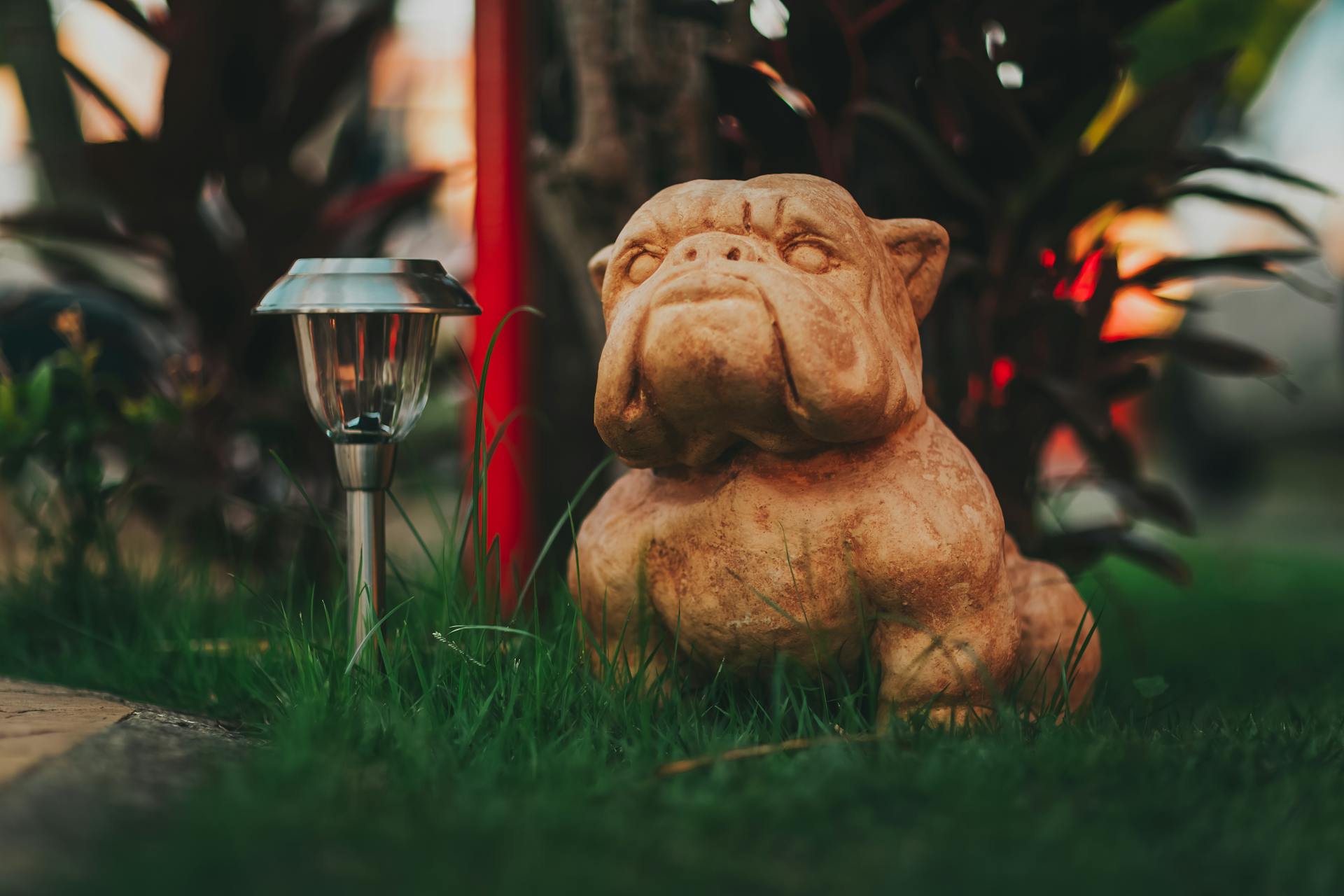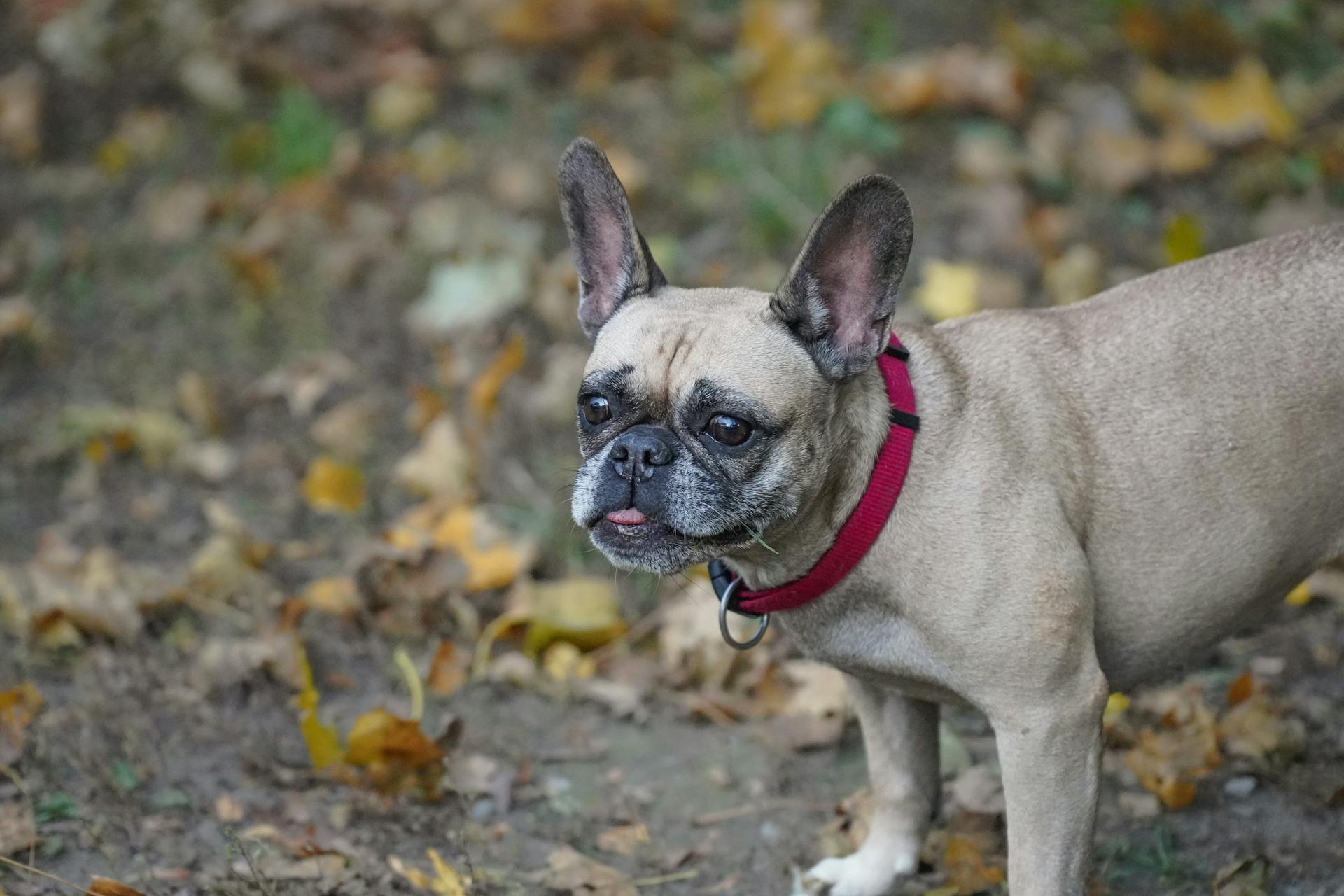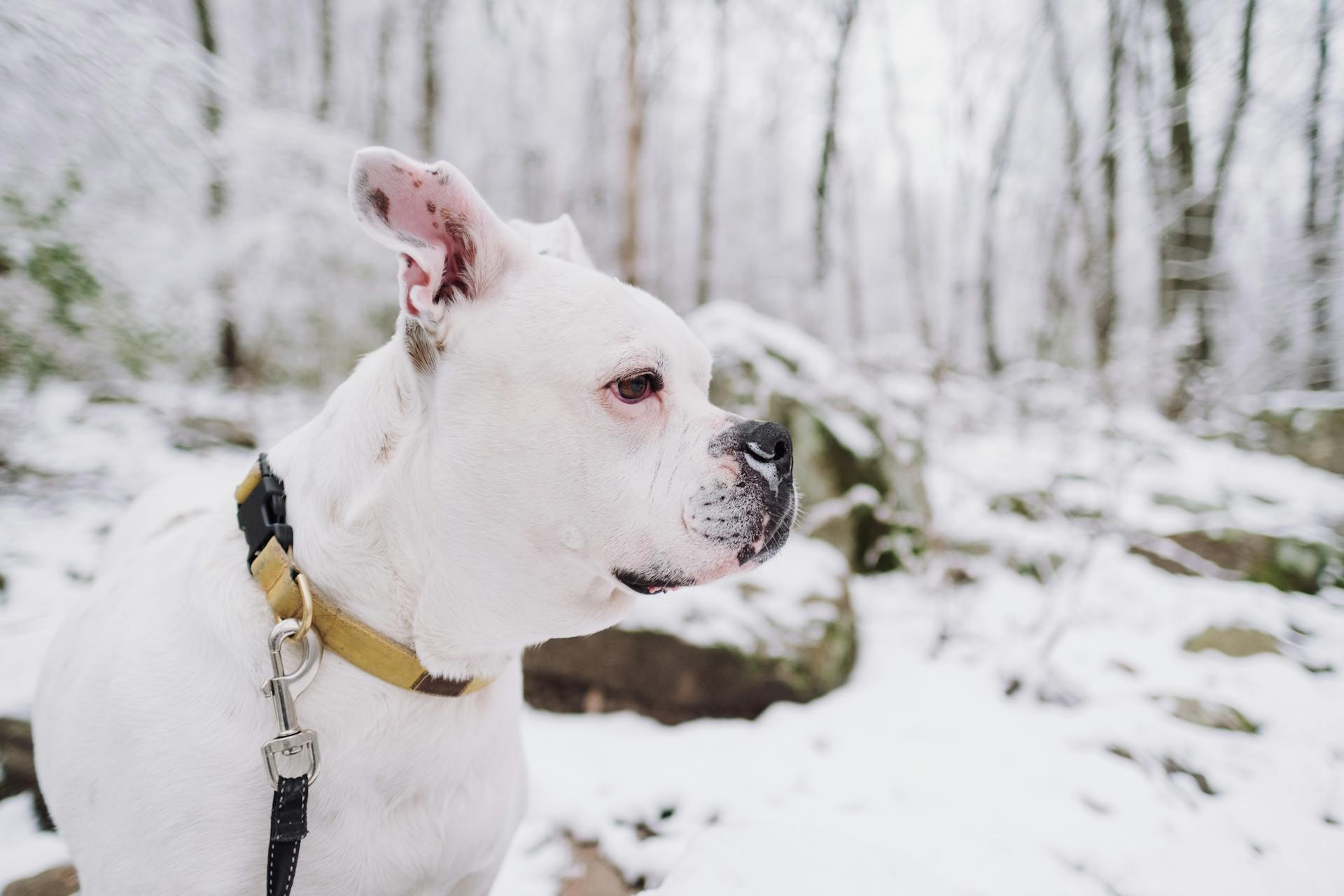
English Bulldogs have specific dietary needs due to their brachycephalic skull structure, which can lead to breathing difficulties if they eat too quickly.
Their short, compact bodies also require a diet rich in protein to maintain muscle mass and prevent obesity.
Choosing the right ingredients is crucial, and a balanced raw diet for English Bulldogs should include a mix of meat, bones, and organs.
They thrive on a diet of 80% meat, 10% bones, and 10% organs, which provides the necessary nutrients for optimal health.
Consider reading: English Bulldog Diet
Why English Bulldogs Need a Raw Diet
English Bulldogs are prone to a range of health issues, including obesity, joint problems, and skin complaints.
Their digestive system is designed to handle a diet high in protein and fat, but not carbohydrates.
Feeding a Bulldog kibble can put their digestive system under pressure, causing inflammation and straining vital organs.
Raw food, on the other hand, is a natural and whole food diet that can help prevent these health issues.
Take a look at this: How Much Food Should a 50 Lb English Bulldog Eat
A Bulldog's stomach is not designed to digest and ferment carbohydrates, which are the main ingredient in kibble.
Grain-free kibble often contains high levels of starchy carbs, including rice, potato, legumes, and lentils.
The intense heat processing used to manufacture kibble denatures the nutrients, leading to advanced glycation end-products, or AGEs, which can cause inflammation and harm a Bulldog's health.
Feeding Guide
Feeding your English Bulldog a raw diet can seem daunting, but it doesn't have to be. You can choose a reputable supplier of pre-prepared raw dog food to make things easier.
Formulating meals with the right ratios of key ingredients is essential for optimal nutrition. FEDIAF-approved recipes, such as ProDog's Complete raw dog food, can give you peace of mind.
To calculate your English Bulldog's daily raw food intake, you can use the feeding chart below:
You can also use a raw dog food calculator to get a more accurate calculation.
Feeding Chart
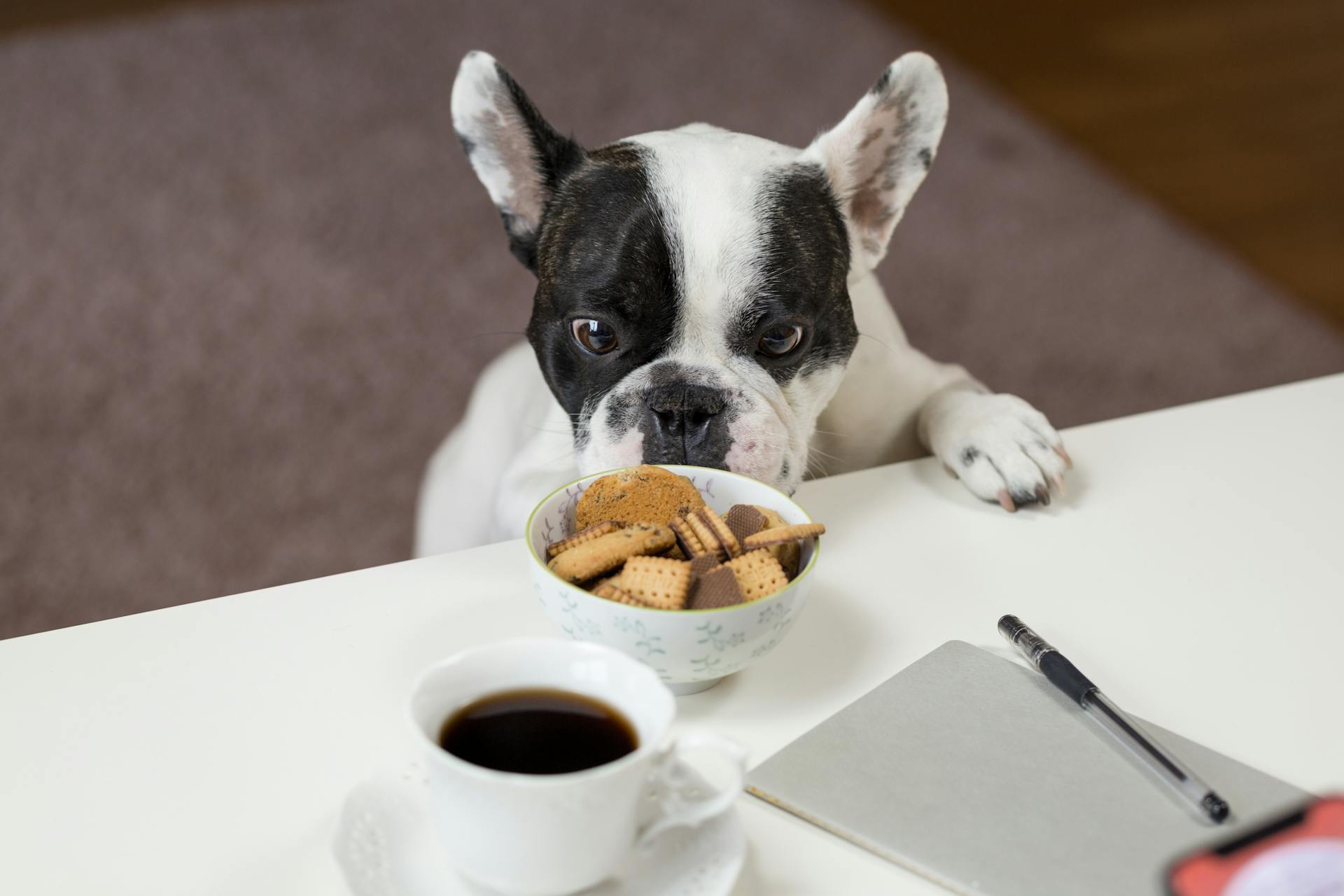
Feeding your English Bulldog the right amount of raw food is crucial for their health and well-being. You can calculate their daily intake by considering their weight, metabolism, activity level, and lifestyle.
For adult English Bulldogs, a general rule of thumb is to feed 2% to 4% of their ideal adult weight. This means if your dog weighs 45 pounds, you'd feed them between 0.90 to 1.80 pounds of raw food per day.
To get a more accurate calculation, you can use a raw dog food calculator or refer to the Feeding Chart below.
- Weight maintenance: Feed 2% – 2.5% of their current weight in pounds daily
- Active dogs (canine athletes, sport dogs, or highly active dogs): Feed 3% – 4% of their current weight in pounds daily
- Senior, less active, or overweight dogs (weight loss): Feed 1.5% – 2% of their current weight in pounds daily
- Underweight dogs (weight gain): Feed 3% – 3.5% % of their current weight in pounds daily
For English Bulldog puppies, the rule is slightly different: they need about 5% to 10% of their weight to support their growth.
Puppy Feeding Chart
As a responsible dog owner, it's essential to understand how much food your puppy needs at different stages of their growth. Puppies 2 to 3 months old require a daily intake of 8% to 10% of their body weight.
To give you a better idea, here's a chart to help you determine the right amount of food for your puppy:
For example, if your 3-month-old puppy weighs 10 pounds, they should be eating around 0.8 to 1 pound of food per day.
Raw Diet Benefits and Risks
A raw diet can have numerous benefits for your English Bulldog, including a shinier coat and improved skin health. This is backed by Dr. Ian Billinghurst, a veterinarian who advocates for raw feeding dogs.
English Bulldogs on a raw diet can also experience more energy and lean, strong muscles. In fact, a raw diet has been shown to improve digestion and increase agility.
Some of the specific benefits of a raw diet for English Bulldogs include smaller, firmer stools, improved dental health, a stronger immune system, lower risk for allergies, and brighter eyes. With a raw diet, your Bulldog can also absorb nutrients faster and manage their weight more effectively.
Benefits of Good Nutrition
A well-nourished English Bulldog is a happy English Bulldog. Good nutrition can make a huge difference in their overall health and well-being.
One of the most significant benefits of a raw diet is improved digestion. This can lead to smaller, firmer stools, which is a sign of a healthy gut.
A raw dog food diet can also improve skin and coat health, giving your English Bulldog a shiny coat and bright eyes. This is because raw food is rich in nutrients that promote healthy skin and coat growth.
In addition to these benefits, a raw diet can also reduce allergy symptoms and improve your English Bulldog's immune system. This can lead to fewer trips to the vet and a happier, healthier dog.
Here are some of the key benefits of a raw diet for English Bulldogs:
- Improved digestion
- Smaller, firmer stools
- Improved skin and coat health
- Reduced allergy symptoms
- Improved immune system
- More energy
- Lean, strong muscles
- Weight management
By providing your English Bulldog with a balanced and nutritious diet, you can help them live a long, happy, and healthy life.
Risks
Raw diet enthusiasts often focus on the benefits, but it's essential to acknowledge the risks involved. Contamination is a significant concern, as raw ingredients can pose a higher risk of contamination with harmful pathogens like Salmonella and E. coli.
Feeding whole bones to dogs presents a risk of choking, broken teeth, intestinal obstruction, or internal punctures. This is a serious issue, and it's crucial to take precautions.
Raw diets can be unbalanced, leading to malnutrition, obesity, and other health issues. This is especially true if you're cooking nutritionally unbalanced recipes at home.
Dogs might be allergic to raw ingredients, which can trigger allergies. An at-home dog allergy test can help you pick ingredients that won't cause any issues.
To reduce raw dog food risks, it's essential to take some precautions. Here are some steps you can take:
- Wash all meats, organs, and other raw ingredients thoroughly.
- Purchase human-grade, ethically sourced raw ingredients from reputable grocery stores or butchers known for high sanitary standards.
- Feed only small or ground bones, avoid large or heavy ones, and never provide cooked bones as they can splinter when chewed.
- Freeze meats for at least 2 to 3 weeks to kill any parasites.
Some breeds, like English Bulldogs, are more susceptible to certain risks. Excesses of nutrients like fats are often associated with a raw food diet in these breeds.
A raw diet can also lead to deficiencies of essential nutrients and minerals, such as phosphorus and calcium. This is a critical issue that requires attention.
Choosing the Right Food
The best diet for an English Bulldog is a balanced and species-appropriate one, consisting of high-quality protein, healthy fats, vitamins, minerals, and fibre from vegetables and berries. This is because their digestive tracts have not significantly evolved from when they were undomesticated wolves.
A natural, raw diet can help prevent common health conditions such as obesity, joint, dental, and digestive issues, as well as common allergy symptoms. This is because a raw diet is easier to digest and doesn't put their digestive system under pressure like kibble does.
To ensure you choose the right food for your English Bulldog, consider the following:
- Look for high-quality protein sources such as meat, bones, and offal.
- Avoid kibble, as it can cause inflammation and strain on vital organs.
- Opt for grain-free or dehydrated raw dog food for easier storage and preparation.
Best Brands
When choosing the right food for your dog, selecting a reputable brand is crucial. There are several great brands to consider.
Some popular raw dog food brands include Darwin's, which offers high-protein meals with over 70% protein in each meal. This brand is a great option for Bulldogs.
Here's an interesting read: Best Food for Olde English Bulldog
Respite from Grain Allergies
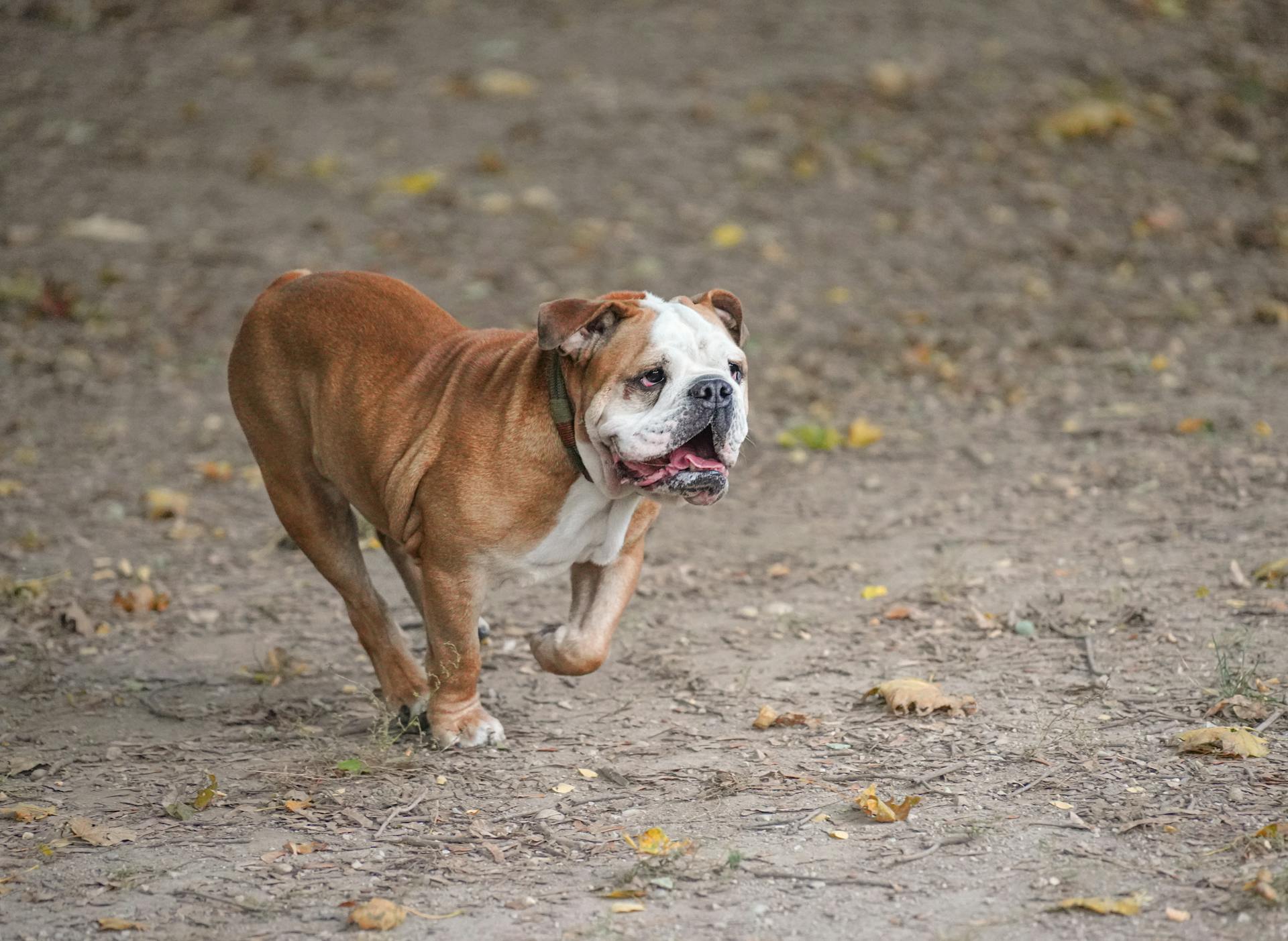
Many bulldogs struggle with grain allergies.
If you're a bulldog owner, you might be wondering what grains to avoid.
Bulldogs can be particularly sensitive to common grains like wheat and barley.
Raw diets, which are grain-free by nature, can be a great option for reducing allergic reactions.
Grains like oats and rice can also be problematic for some bulldogs.
A grain-free diet can provide a much-needed respite from the constant itching and discomfort of grain allergies.
If this caught your attention, see: English Bulldog Skin Allergies Home Remedies
Transitioning to a Raw Diet
Transitioning to a raw diet is a crucial step in ensuring your English Bulldog's digestive tract adjusts smoothly. Abrupt changes can cause stomach issues, diarrhea, or vomiting, so it's essential to do it progressively.
A gradual transition is key, and you can follow a general schedule to make the switch. Start by mixing 25% new food with 75% old food for the first week, then increase the new food to 50% and decrease the old food to 50% for the second week.
Discover more: New English Bulldog
Week 3 is where things get interesting, as you'll be decreasing the new food to 25% and increasing the old food to 75% again. This may seem counterintuitive, but it allows your dog's digestive system to settle back into its old rhythm before making the final switch to 100% new food in week 4.
Alternatively, you can follow a 14-day transition plan, where you serve 80% old food with 20% new raw food for the first three days, then increase the new food to 50% and decrease the old food to 50% for the next three days. After that, you'll be serving 20% old food with 80% new food for the remaining seven days, finally making the switch to 100% new food on day 15.
Remember, it's always better to err on the side of caution and make the transition even more gradual if you know your dog is sensitive to new foods.
Broaden your view: English Bulldog Puppies Week by Week
Health and Wellness
A healthy gut is essential for your English Bulldog's overall health, and tracking their weight and gut health is crucial when switching to a new diet.
Rapid weight increases or decreases can be a sign of food-related health issues, so monitor your dog's weight closely.
An at-home dog gut health test can provide valuable insights into your dog's gut health, helping you identify any potential issues early on.
Skin or coat issues, excessive tiredness, allergies, weight loss, malnutrition, and obesity can all be caused by an unbalanced diet, so keep an eye out for these symptoms.
If this caught your attention, see: Olde English Bulldogge Weight Chart
Monitor Weight & Health
Monitoring your English Bulldog's weight and health is crucial, especially when switching to a new diet. A healthy gut can confirm a smooth transition to your dog's new diet, among other health issues.
Rapid weight gain or loss might be due to food-related health issues, so keep an eye on that. Skin or coat issues, excessive tiredness, allergies, weight loss, malnutrition, and obesity can be caused by unbalanced and insufficient meal plans.
See what others are reading: English Bulldog Losing Patches of Hair
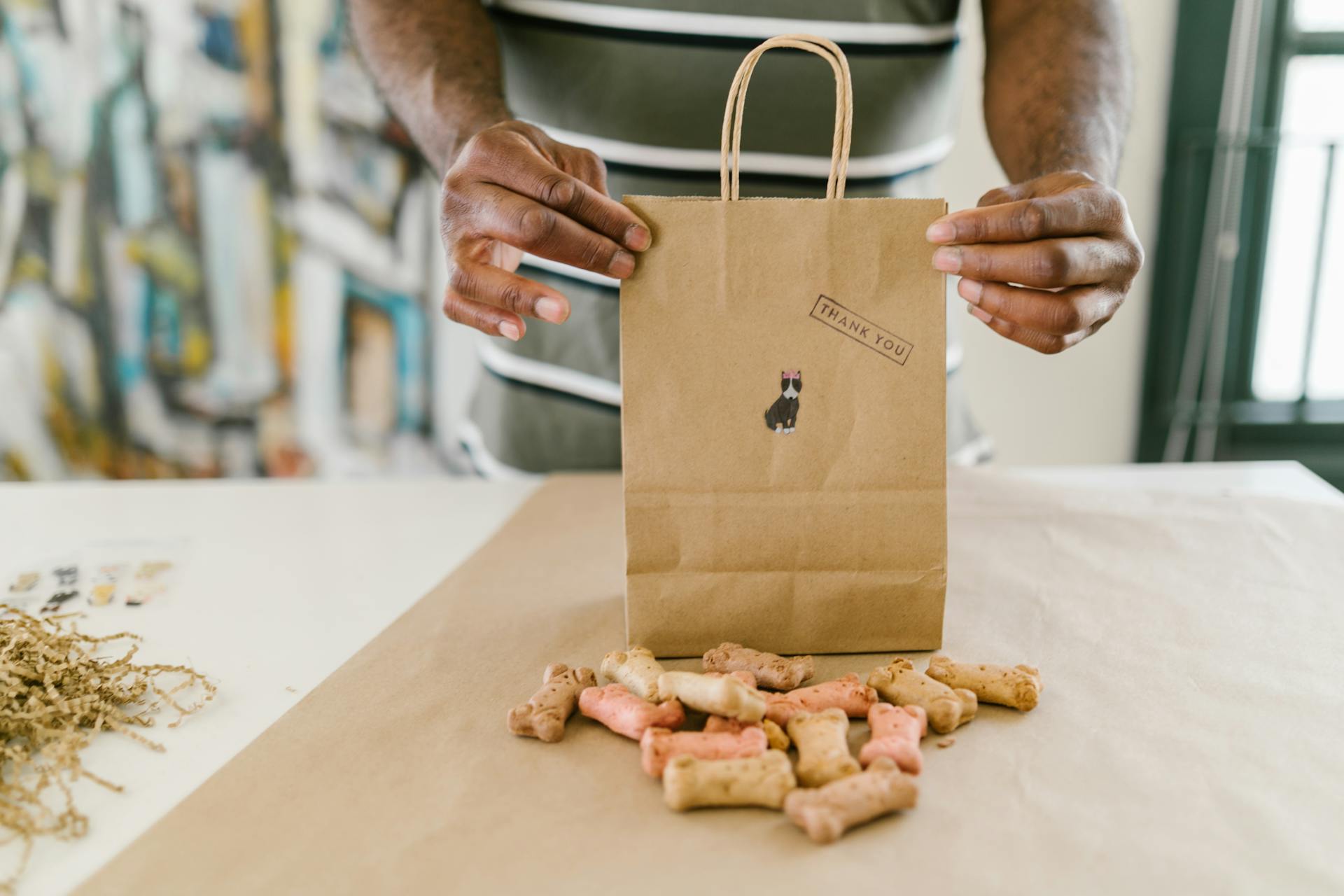
An at-home dog gut health test can provide insights into your dog's gut health, making it easier to identify any potential problems. If you detect any of these symptoms while feeding your English Bulldog meals, stop doing it immediately and seek expert advice.
A raw dog food diet can offer numerous benefits for your English Bulldog's health and well-being, including maintaining a healthy weight, boosting their immune system, and improving their digestion. However, consult with a veterinarian or animal nutritionist before starting your English Bulldog on a raw food diet to ensure their nutritional needs are met and any potential health risks are addressed.
Here are some common signs of an unbalanced diet:
- Skin or coat issues
- Excessive tiredness
- Allergies
- Weight loss
- Malnutrition
- Obesity
By prioritizing your dog's health and well-being, you can make informed dietary choices that benefit their overall health.
Suggestion: English Bulldog Health Concerns
Heart Disease
Heart disease is a serious concern for many dog breeds, particularly Bulldogs. The cause of dilatative cardiomyopathy (DCM) among dogs fed raw, grain-free, homemade, and other "boutique exotic" niche diets is still unknown.
Research suggests that a lack of a critical amino acid named Taurine was once thought to be the culprit, but recent cases have shown normal taurine levels.
Feeding your Bulldog a balanced diet is crucial to prevent heart disease.
Raw Diet Recipes and Preparation
Raw diet recipes for English Bulldogs can be a great way to ensure your furry friend is getting the nutrients they need. Consider making your own raw dog food at home using recipes like Balanced Raw Delight or Beefy Raw Patties.
Before starting a raw diet, it's essential to consult with your veterinarian to determine the best course of action for your English Bulldog's specific needs. They can help you determine the right serving sizes based on your dog's breed, weight, age, activity level, and health.
You can find more raw dog food recipes in cookbooks like A Novice’s Guide to Raw Feeding for Dogs, which can provide a wealth of information and inspiration for creating healthy meals for your English Bulldog.
Can You Create Your Own Recipes?
Creating your own raw dog food recipes can be a great way to take control of your Bulldog's diet. However, it's not for the faint of heart.
You'll need to ensure your Bulldog gets a proper balance of protein, fat, carbs, and nutrients. This can be tricky, especially if you're new to raw dog food.
Even with experience, creating raw dog food recipes can be risky if you don't know what you're doing. Consult a vet or canine nutritionist for advice if you're unsure.
Creating your own recipes can help you feel more confident about your Bulldog's health in the long run. You'll know exactly what's going into your dog's meals.
Raw dog food brands are generally safer and more convenient for Bulldog parents using raw food for the first time. They provide a nutritionally-balanced meal for your furry friend, with less risk involved.
Recipes
If you're looking for some delicious and healthy raw diet recipes for your English Bulldog, you're in the right place. Here are some of our favorite recipes that are perfect for this breed.
Note: Always consult your vet before making any changes to your dog's diet, as serving sizes will depend on their breed, weight, age, activity level, and health.
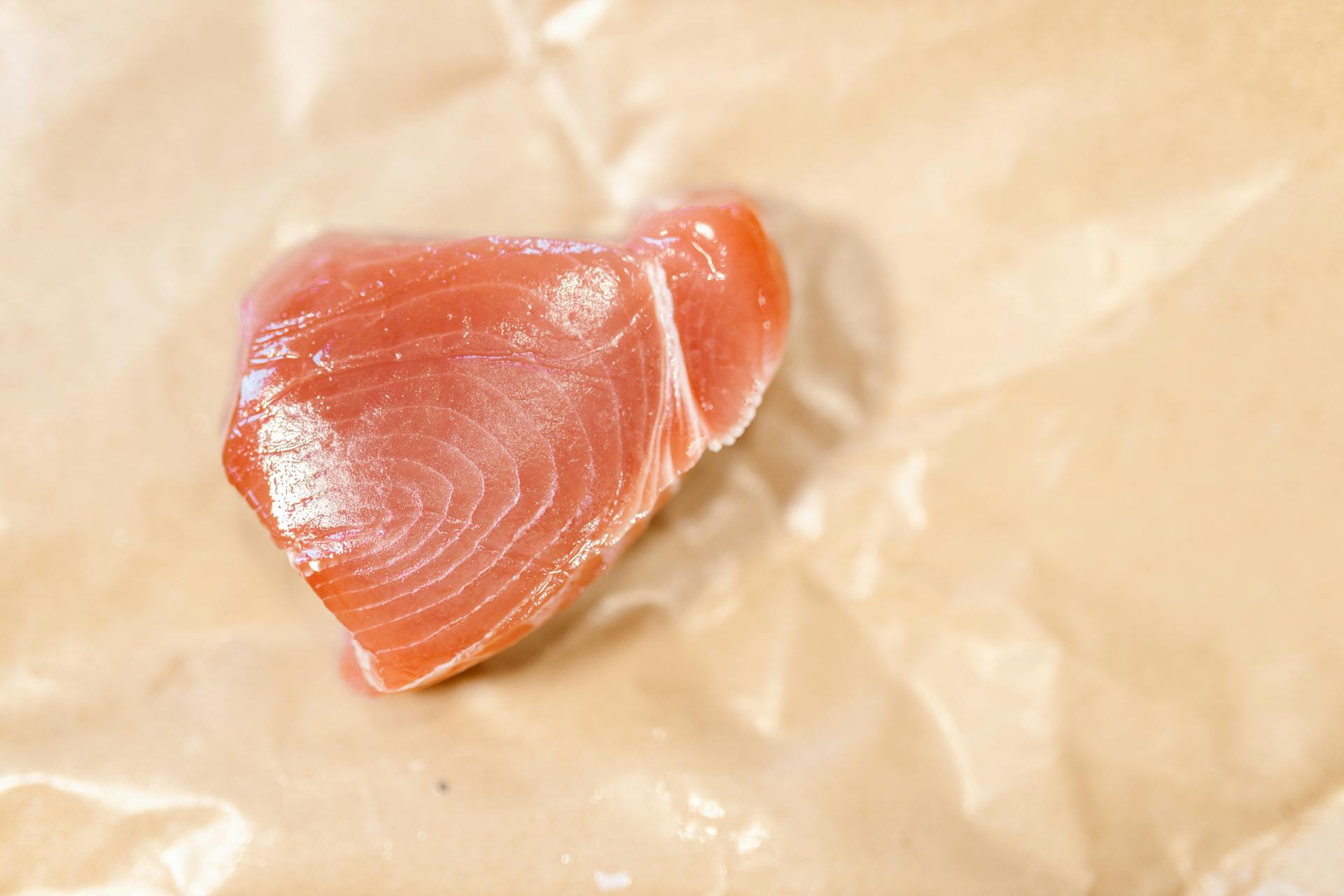
Some popular raw diet recipes for English Bulldogs include Balanced Raw Delight, CBD Infused Treat, Beefy Raw Patties, Raw Boneless Turkey, Organ Patties, and Chicken & Greens.
You can find more recipes in cookbooks like A Novice’s Guide to Raw Feeding for Dogs, which is a great resource for anyone looking to switch to a raw diet.
A natural, whole food diet is the best way to keep your dog healthy and happy, and can even prevent common health issues like obesity, joint problems, and digestive issues.
Here are some key ingredients to include in your raw diet recipes:
- High-quality protein sources like meat, bones, and offal
- Healthy fats and oils
- Vitamins and minerals from vegetables and berries
- Fiber from vegetables and berries
It's essential to choose a diet that's balanced and suitable for your dog's life stage and energy needs.
Best Cooking Practices
When preparing a raw diet for your English Bulldog, it's essential to cook the food safely and effectively.
First and foremost, ensure your dog's meal is balanced. This means providing a mix of protein, fat, and carbohydrates that meets their nutritional needs.
Liver and other organs might be slimy, so be cautious and cut them into bite-size pieces to avoid choking.
To avoid using toxic ingredients, do not use inadequate or dangerous recipes. Always prioritize your dog's health and safety.
To make the diet more affordable, consider visiting your local Mexican, Asian, or farmer's market to find a broader variety of cheaper organ meats. Alternatively, you can have frozen organ meats packed in ice and delivered directly to your door.
Lean ground products are a must when preparing a raw diet. Try to feed the leanest ground products possible to ensure your dog gets the nutrients they need.
If you're new to raw dog food, it's crucial to understand the impact of food and dietary changes on your dog's health. This will help you make informed decisions and avoid any potential issues.
Switching to a raw diet gradually is also essential to avoid shocking your dog's digestive system. This will help ensure a smooth transition and reduce the risk of any adverse reactions.
Here are some key cooking practices to keep in mind:
- Understand your dog's nutritional needs
- Do not use inadequate or dangerous recipes
- Ensure your dog's meal is balanced
- Do not use toxic ingredients
- Understand the impact of food and dietary changes
- Switch to raw gradually
- The diet must be based on your dog's life stage nutritional needs (puppies, adults or seniors)
Financial Motives
The financial motives behind some raw diets for English bulldogs are suspect. Quality control is often compromised due to funding priorities.
Let's take a closer look at the areas where cost-cutting measures might be taken. The list below highlights some of the potential sacrifices made for profit:
- Quality control
- Safety
- Scientific research
- Testing
- Certified nutritionist oversight
Manufacturers may prioritize their own interests over the health and well-being of the dogs. It's essential to be aware of these potential risks to make informed decisions about your bulldog's diet.
Final Advice
As you navigate the world of raw diets for your English bulldog, remember that simplicity is key. Keep your diet straightforward and easy to manage, avoiding unnecessary complications.
More is not always better when it comes to your bulldog's raw diet. In fact, excessive amounts can be detrimental to their health.
Don't be swayed by new and popular trends in raw diets, as they may not necessarily be safer for your bulldog. Safety should always be your top priority.
Be aware of buzz words and marketing terms that are intended to attract you, but may not be beneficial for your bulldog. Focus on what's truly important for their well-being.
Avoid fancy packaging and labeling, which may be more about impressing you than providing actual benefits for your bulldog. Stick to what works.
A high price tag does not always mean a high-quality raw diet for your English bulldog. Look for value and quality, not just a hefty price.
Here are the simple raw diet rules of thumb to keep in mind:
- Keep it simple.
- More is NOT always BETTER.
- New & popular does NOT necessarily mean SAFER.
- Buzz words are intended for you, NOT your BULLY.
- Fancy packing is intended for you, NOT your BULLY.
- A high $$$ price tag does NOT always equate with QUALITY & VALUE.
Frequently Asked Questions
Can I feed my English bulldog raw chicken?
Yes, in moderation, raw chicken can be a nutritious addition to your English bulldog's diet, leveraging their unique digestive system and evolutionary history. However, consult with a veterinarian before making any changes to ensure a balanced and safe feeding plan.
How much raw food to feed an English bulldog puppy?
Feed your English bulldog puppy 5-8% of their weight in raw food, divided into 3 meals a day until 6 months, then 2 meals a day until 1 year. After 1 year, switch to the adult feeding plan.
Sources
- https://www.prodograw.com/raw-feeding-guide/bulldog-feeding-guide/
- https://english-bulldog.shop/english-bulldog-raw-diet
- https://www.caninebible.com/english-bulldog-raw-dog-food-diet/
- https://vet4bulldog.com/prevents-treat/raw-diet-french-bulldogs-english-bulldogs/
- https://iheartdogs.com/best-raw-dog-food-brands-for-bulldogs/
Featured Images: pexels.com
